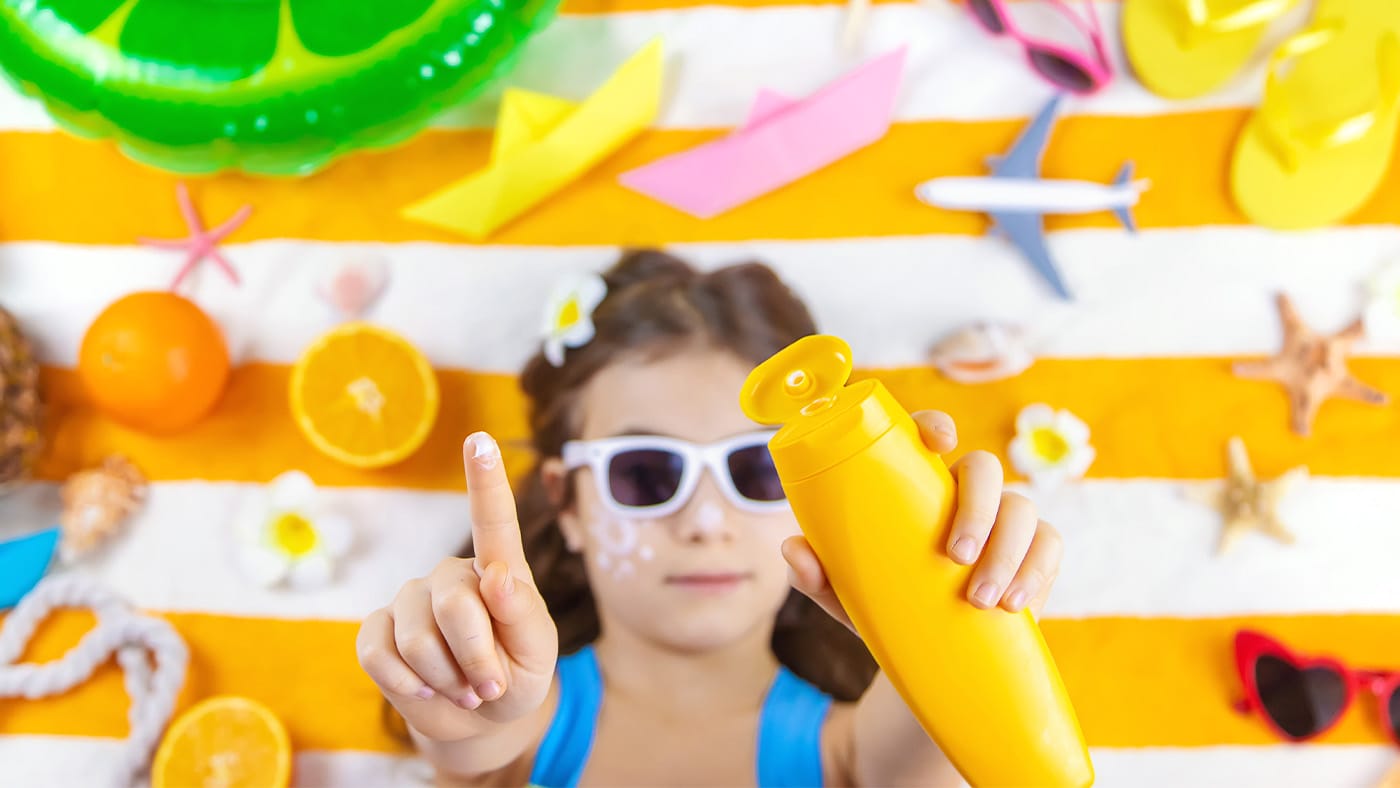With the cold winter months finally behind us, many kids are looking forward to spending time outside and feeling the sun’s warmth on their faces. Whether you’ve got young children at home or older kids out of school for the summer, they’re likely to get more sun exposure than usual during the summer months. Overall, that’s a good thing! Playing outside is excellent for a child’s physical and emotional well-being, but there is such a thing as too much of a good thing.
Sunshine brings light and warmth, but it also carries harmful ultraviolet radiation that can cause skin damage, sunburn, eye damage, and skin cancer. The amount of UV radiation in your area depends on the time of year, proximity to the equator, and several other factors; however, UV radiation is at its highest in the summer months.
Keeping Kids Safe in the Sun
Stay sun safe this summer while protecting your child’s skin while you enjoy the sunshine with these tips:
- Model sun safety: Wear sunscreen, hats, and sunglasses. Show your child how you stay sun-safe, so they can see how it’s done.
- Watch the clock: UV radiation is strongest when the sun is high in the sky. Schedule activities before or after midday, whenever possible. Keep children out of direct sunlight between 10:00 a.m. and 4:00 p.m.
- Keep babies inside: Babies younger than one year should not be exposed to direct sunlight. Keep them inside or in the shade with protective clothing when outside during the day. Use sunscreen only on small, exposed areas if absolutely necessary.
- Dress for the heat: Dress your children in loose, lightweight, light-colored clothing to avoid overheating and to protect them from UV radiation. Make sure clothing isn’t sheer. If you can see through the fabric, UV radiation can also pass through it. Check clothing labels for UV protection ratings.
- Bring the shade: Accessorize your child’s summer outfit with a wide-brimmed hat and sunglasses. Look for sunglasses that offer built-in UV protection. You can’t always depend on shade trees, awnings, or other environmental features for shade. If you’re going out for an extended period, consider taking a large umbrella, a pop-up tent, or other means of portable shade.
- Stay hydrated: Kids lose water from their bodies more quickly when running around in the hot summer sun. Make sure they have access to plenty of water so they can stay hydrated all day long.
- Wear sunscreen: Sunscreens contain compounds that block UV radiation from reaching the skin. Apply waterproof sunscreen with an SPF (sun protection factor) of at least 30 to keep your kiddos safe outside.
- Check medications: Some medications may increase a child’s sensitivity to UV rays. Discuss any risks associated with your prescriptions with your pediatrician or pharmacist.
Sunscreen Tips for Kids
Commonly available sunscreens either have compounds that physically block UV rays, like zinc oxide or titanium dioxide, or they have chemical blockers that absorb UV rays. The AAP recommends mineral-based sunscreens (zinc oxide) over chemical-based options (oxybenzone). Ensure your child gets the most protection possible from their sunscreen with these tips.
- Test first: Apply sunscreen to a small area of the body, particularly when applying it to your child for the first time. Watch for a rash or irritation before applying to larger areas of the body.
- Cover everything: Apply sunscreen to all exposed parts of the body. Remember to protect the back of the knees, tops of the shoulders, noses, and tops of the ears, as these areas are commonly overlooked and prone to sunburn.
- Protect on cloudy days: People often think clouds are nature’s sunscreen, but UV rays can get through cloud cover and impact you even on overcast days.
- Apply early: If you want sunscreen to be as effective as possible, apply at least 30 minutes before sun exposure.
- Go broad-spectrum: There are three types of UV radiation: UVA, UVB, and UVC. UVC radiation doesn’t get through the atmosphere, but UVA and UVB do. A broad-spectrum sunscreen will protect your child from both types of harmful UV radiation.
- Avoid inhalation risks: Use mineral-based sunscreen lotion or sunscreen sticks to avoid inhalation risks in children. When spray sunscreen is your only option, spray it into your hands before applying it to children.
- Reapply often: Sunscreen is one of the most effective tools for protecting kids (and adults) from the sun, but it doesn’t last forever. Reapply sunscreen every two hours, more often if the UV index is high.
Sunburn Relief for Children
Despite the best efforts, most children will get sunburned at least once or twice in their lives. Symptoms of sunburns include pain and sensitivity at the affected area, skin feels hot, blisters, and dry, itchy, peeling skin.
Most of the time, sunburns are relatively mild and resolve on their own. Here’s how to care for your child and keep them comfortable while they recover from a sunburn.
- Cool water: Give your child a cool bath or apply cool, wet compresses to the skin to help reduce the heat and soothe the pain.
- Aloe vera: Apply a moisturizing cream or gel, including aloe vera. These products are commonly available and may soothe the burn and promote healing. Avoid any petroleum-based products as they make it difficult for heat and sweat to escape the body.
- Pain medication: If pain persists, you can use child-safe doses of over-the-counter pain medications, such as ibuprofen or acetaminophen.
- Liquids: Staying hydrated is just as important after spending time outside as when you’re out in the sun. Providing plenty of liquids will help your child heal. Water, coconut water, drinks with electrolytes, or popsicles help keep your child hydrated.
- Minimal touch: Depending on the severity, your child may experience blisters and/or cracked and peeling skin. Avoid scratching, popping, squeezing, or fiddling with blisters or peeling skin. This can lead to infection or scarring.
- Get help: If you see more serious symptoms like fever, chills, headache, stomach ache, or confusion following a sunburn, contact your child’s pediatrician.
Tanning For Teens
Tanning might seem like a summer glow-up, but there’s no such thing as a safe tan. Encourage your teens to protect their skin to avoid wrinkles, spots, and the possibility of skin cancer.
- Use sunscreen: Encourage your teen to wear sunscreen any time they go outside. It helps prevent sunburn, long-term skin damage, and reduces the risk of skin cancer.
- Avoid tanning beds: Tanning beds expose skin to harmful UV rays and significantly increase the risk of melanoma, especially when used at a young age.
- Use sunless tanning lotions or sprays: If your teen wants a tanned look, recommend safer alternatives like sunless tanning lotions or sprays that don’t involve UV exposure.





